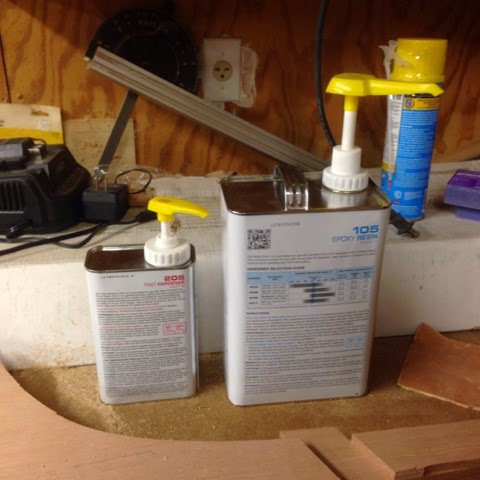5 December 2014
Good progress Wednesday night. It's taken until Friday though to catch up on blogging. Ian, my 13 year old and fellow boat builder, pitched in Wednesday night. The goal was to finish the ladder and perhaps start adding the pre-cut form pieces. We got the first part done.
While we build the skiff, we are also building a hovercraft for Ian's Falmouth Academy Science Fair (always a big deal at FA). He has made good progress to date. The forecast is for a solid weekend of rain, so we should get the blower properly aligned and attached this weekend.
The picture below shows where we left things after 2 hours of work. I had to replace one of the 12 foot 2x6's for the ladder due to excess cupping. I believe the horses will
just do wrt to the width of the ladder, but we might have to build out a broader top. I assume I will more or less permanently fix the ladder to the horse, so I can get close to the edge. We struggled a bit trying to figure out if the front face or the middle or the back face of the form should align with the 3', 6', etc. marks on the ladder. After breaking out the square we decided that the plans called for the
front face of each of the form pieces is on the mark. We pre-drilled and screwed in the plywood pieces with just a couple of screws, so we'll be able to adjust them easily and get the whole thing straight and flat.

We aligned the bottom edge of the plywood pieces to the bottom of the 2x6's. This lead to the last cut on the form, the one at the bow, to overlap the 2 by. I cut a little of the 2x6 to make room.
I don't want to give away the plans of course, but I did want to show the scale and level of detail provided. I think the scale is 1" to 1.5 foot. That is a one foot rule on the plans. Dough Hylan provides a dozen or so pages. They're very clear (so far!) and well printed, even for my tired, old eyes.
This got turned upside down in the camera, but it shows you the level of detail on this sheet.

pretty much as we left on Wednesday night. We promised ourselves that we would take a picture every time we did something on the skiff. I made a little holder for camera. May have adjust it a bit. If all goes well, we'll be able to make a time lapse. I also started an excel sheet to keep track of the time spent building.









































